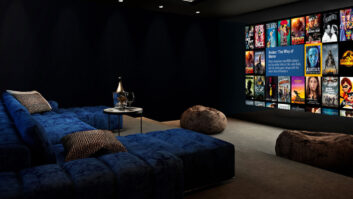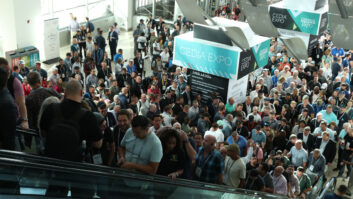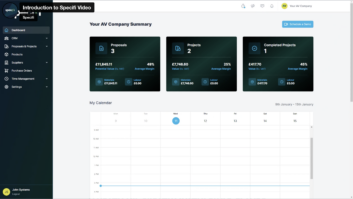Sound quality is inherently subjective, so it’s only natural that the sources audio and home theater systems’ designers use to align and tweak them would be personal, perhaps even quirky too. Here’s a look–rather, a listen–at what some top home theater and audio environment designers are using to test their sound systems. The Media That Top INTEGRATORS Use to Test and Align Audio

Chris Montreuil, of DSI Entertainment Systems, believes Peter Weir’s Master and Commander is “the best sustained dynamics test you can ever have on a single disc.”
Who: David Frangioni, Audio One, Miami, FL
What: Paris Concert for Amnesty International DVD

The Paris Concert for Amnesty International is a good demo for its range of music types, and for David Frangioni of Audio One, knowing what the concert was like live allows him to hear what the sound does in a room.
It doesn’t hurt that David Frangioni, director of Audio One in Miami, is also a recording engineer and music technologist of note with engineering, programming, and production credits including Aerosmith and Ozzy Osbourne. “I like to use recordings that I was part of the making of as reference audio for home systems,” he said, including the Amnesty International benefit concert he recorded in Paris in 1998, featuring Shania Twain, Bruce Springsteen and Peter Gabriel, a DVD that gives a 5.1 system a nice workout. “There’s a big variety of music types on that DVD, so it has a lot of range, but what makes it really work for me is that I know what it sounded like live, and I know what the translation of it from live to disc sounds like, so I can really hear through the music itself and listen to what it’s doing in the room,” he explained.
However, before he gets to complex music as a reference, Frangioni starts out with test tones he recorded himself, a CD for stereo reference and a Dolby Digital-encoded DVD for 5.1. “That way, I’m not dependent on the processor [generated tones],” he said. “It gives me a common reference that’s the same for every room I work in. That’s my starting point. I’ll use an SPL meter and write down the levels at various frequencies in different parts of the room. Then I’ll start running the music through the system.”
But if he were stranded on a desert isle with nothing but a home theater and a tweaker, what would he want as a reference? The Rock, he said, referring to the 1996 Sean Connery apoca-thriller. “I know that film so well that give me 30 or 40 seconds of any scene, and I’ll know exactly what’s going on with a room.”
Who: Chris Montreuil, DSI Entertainment Systems, Los Angeles, CA
What: Master & Commander DVD
The first time Chris Montreuil used the DVD of director Peter Weir’s Master & Commander to test out his home theater’s audio system, it tripped a switch in his main breaker panel.
“It happened during the first battle scene between two ships in the movie, and it’s the best sustained dynamics test you can ever have on a single disc– it’s just insane,” he said. The movie offers more than just subwoofer-torturing bombast though. Montreuil, systems designer at DSI Entertainment Systems, uses a scene in which crewmembers walking on deck are shot from below to get the positioning of the surrounds just right. If the surround field is well integrated, you get a good sense of movement front to back and side to side,” he said.
Montreuil uses standard calibration discs to tune systems, but prefers M&C for the final tweak. “It really shows clients what a system is capable of doing,” he said.
Who: Sean Barton, Beyond Home Theater, Santa Monica, CA
What: Tracy Chapman’s “Fast Car,” James Taylor’s “That’s Why I’m Here” .wav files
Sean Barton is a veteran of the Harman Listening Lab, where he said he came to the conclusion that many audiophiles use a particular music track because it has a solo feature, such as a guitar or a voice, they feel provides an anchor point from which to listen. “They have a clear understanding of the track, but the downside is that it’s only going to use a narrow frequency range,” he said. Instead, Bartone relies on .wav files of Tracy Chapman’s cut “Fast Car” and James Taylor’s “That’s Why I’m Here,” as well as Joan Osborne singing “Heat Wave” from the Standing In the Shadows Of Motown DVD.

Material that features low non-linear distortion and represents the full audio bandwidth, like the .wav file of Tracy Chapman’s “Fast Car,” makes colorations in a sound system more audible.
“When doing an audio evaluation, it is important to use music over movies; specifically, it is important to use tracks that are well recorded, have low non-linear distortion, and represent the full audio bandwidth,” he explained, “These particular tracks were measured under meters and meet this criteria, and they are used by several audio manufacturers for testing purposes. This type of program material makes colorations in the system more audible, allowing you to determine whether a system sounds boomy, bright, muddy, or however you personally describe audio quality.
“Once you have tested your system with these reference tracks, I always find that live concerts make the best audio demo for the client because they create live experience, which is a real treat. One that I prefer is the Chris Botti Live in Boston Blu-ray. It’s very well recorded and has some great performances that bring out a world-class audio system.”
Who: Carl Tatz, Carl Tatz Designs, Nashville, TN
What: Vertical Limit, assorted CDs

Carl Tatz, of Carl Tatz Designs, uses a gutwrenching scene from Vertical Limit to test a system’s low end.
There is a moment in the intensely focused film Vertical Limit when (spoiler alert!) a body hits the ground at terminal velocity, ending a gut-wrenching scene. The combination of emotion and the complex thump that gives you a chance to hear its reverberation fade is why Carl Tatz likes to use the scene to check the audio system’s low end. “If the emotional impact doesn’t feel right, then I know I have to bump up the subs a bit,” he said.
When tuning hybrid systems that will be used for both 5.1 theater and stereo critical listening, Tatz relies on Nora Jones’ hit “Don’t Know Why” and Jamie Cullum’s “Blame It On My Youth” for their airy vocal imaging to check his Phantom Focus imaging technique, and Donald Fagen’s “Mary Shut The Garden Door” to check lowfrequency response. But after all the niche frequencies are properly ringed out, Tatz goes back to James Taylor’s “Line ‘Em Up: from the Hourglass LP. “It’s a spectral tour de force,” he calls it. “It’s the best-sounding record across entire music frequency spectrum. It’s always the last one I listen to.”
Who: Joe Hart, HiFi House, Broomall, PA
What: analog ’70s jazz

Charlie Byrd’s analog-recorded jazz track “Old Hymn” has one of the best recorded drum kits ever, according to Joe Hart of HiFi House, who believes drum kits provide great nuances for listening to a music system with.
Joe Hart likes to use analogrecorded jazz tracks that date back 30 or so years, particularly those from Crystal Clear Records, which used direct-to-disk cutting techniques to create 45-rpm LPs. “Their recording of Charlie Byrd’s ‘Old Hymn’ has one of the best recorded drum kits ever, and the dynamics of a drum kit give you excellent nuances to listen to a music system with,” Hart said.
The a capella blues/gospel group Fairfield Four’s recording of “These Bones” offers similar granularity with just the human voice to listen to. “The contrast between the voices is amazing and you can tune with the voice in a much more specific way than with an instrumental recording,” he said.
Who: Anthony Rago, Stereo Exchange, New York, New York
What: Louis Armstrong’s “St. James Infirmary”

With an emphasis on the two-channel experience, Stereo Exchange’s Anthony Rago looks to vintage recordings like Louis Armstrong’s “St. James Infirmary,” for demo material.
With its emphasis on the twochannel experience, it’s not surprising that Stereo Exchange’s Anthony Rago looks to vintage recordings to share what he calls stereo’s three-dimensional experience with customers. “We’re not spec oriented here; we’re into the actual subjective experience that you get from great music beautifully recorded,” he said, citing a late 1920s recording by Louis Armstrong, “St. James Infirmary” as a prime example. “It’s a very old recording, but beautifully engineered; you can clearly hear each instrument as it comes in, the clarinet, Louis’ trumpet, the string bass, the drums, and then his vocal,” Rago said. “It’s dynamic and amazing and a great way to show someone a great stereo experience. You can really understand the three-dimensionality of stereo.”
Rago said older, classical recordings can produce similar results, citing the engineering culture of the pre-digital era, but he sticks to the vinyl versions when he can, from sources like the Living Stereo series. “Those recordings came out of a culture where you had these fantastic engineers at RCA and Mercury and other labels like that,” he said. But he’s also fond of Pink Floyd, Radiohead, and John Mayer as well. “The thing to look for is great engineering and recordings with a lot of detail that you can point to,” he said.
Who: Brad Weintraub, Integrisys, Chicago
What: Bela Fleck, Dave Matthews

The wide range of frequencies combined with a lot of definition and distinction between instruments makes Dave Matthews’ and Tim Reynolds’ DTS ES Blu-ray acoustic edition makes for an ideal surround system demo.
When it comes to music in surround, the choices are less limited than they once were. Brad Weintraub, a principal at Integrisys in Chicago, will go to the classics like Elliot Scheiner’s 5.1 remix of the Eagles Hell Freezes Over, but he also has the Dave Matthews and Tim Reynolds DTS ES Blu-ray acoustic edition, as well.
“Anything where instruments with a wide range of frequencies and a lot of definition and distinction between the instruments,” he said. “Bela Fleck records are another great example–they have a lot of great low end stuff on the bass side and lots of other types of acoustic instruments. I like to use what people are familiar with and relate to because at the end of the day, it’s an emotional decision. You want them to know the music and discover the system.”
Who: Jim Ares, director, ADTECH’s residential division, Home Entertainment Expo, Sudbury, MA
What: Eric Clapton, Crossroads Guitar Festival 2010

Eric Clapton’s Crossroads Guitar Festival on Blu-ray gives the option of conventional stereo or a DTS HD 5.1 surround mix.
While the Eagles 5.1 remix of Hell Freezes Over has been a popular surround music staple for some time, Jim Ares was always embarrassed by the quality of the picture. “It’s DVD but it was shot on film, which has a very different look, and it distracts from the music,” he said.
The arrival of Clapton’s multi-artist Guitar Festival on Blu-ray last year solves that problem and offers a choice of conventional stereo or a DTS HD 5.1 surround mix for the music. “Music on Blu-ray makes a huge difference,” Ares said. “The picture is as good as the music.”
And the range of artists on the disc, from Clapton to Buddy Guy, David Hidalgo and Cesar Rosas of Los Lobos, Derek Trucks, Jeff Beck, Jimmie Vaughan, John Mayer, Keb’ Mo’, Warren Haynes, and ZZ Top, hits the affluent hipster sweet spot that Ares said the high-end system sales aim for. “And it’s recorded live, so you don’t have that sense that its studio-perfect recording,” Ares adds. “That makes it a little bit edgy.”
Dan Daley is a freelance writer based in Nashville, TN.







